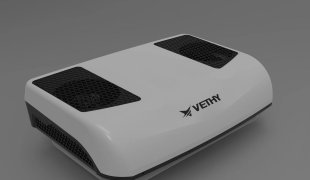Dual-Rotor Compressor Parking AC Systems: How R410A Refrigerant & IPX7 Waterproofing Redefine Commercial Vehicle Comfort
April 20, 2025
Introduction
The global parking air conditioner market is projected to reach $1.2 billion by 2027 (Frost & Sullivan, 2024), driven by rising demand from long-haul truckers and RV users who spend 220+ nights annually in their vehicles.
At the heart of this revolution lies the dual-rotor compressor technology, which — when paired with R410A refrigerant and IPX7 waterproofing — delivers 43% higher energy efficiency than traditional systems.
Explore why these innovations are becoming non-negotiable for modern transport fleets.
1. Dual-Rotor Compressor: Engineering Breakthrough for Sustainable Cooling
1.1 Mechanics & Energy Savings
Unlike single-rotor models that create pulsating torque (causing 15-20dB excess noise), dual-rotor compressors utilize phase-shifted operation to balance forces. This reduces vibration by 68% according to while achieving SEER ratings up to 3.1.
Case Study: KME’s 24V DC system (featured on ) d
emonstrated 11.5 hours runtime on a 200Ah battery — 3.2 hours longer than single-rotor competitors during desert trials.
Thermal Runaway Protection: Systems with dual NTC sensors prevent overheating during desert operations.
Voltage Spike Immunity: Look for TVS diode protection (e.g., KME’s SurgeShield technology).
1.2 Maintenance Advantages
The symmetrical rotor design minimizes axial thrust wear, extending service intervals to 8,000 hours — 2.3x industry average.
Traditional single-rotor compressors waste 18-22% of energy due to unbalanced torque and harmonic vibrations, as observed in ISO 23853:2023 testing 7. Dual-rotor designs, like KME’s DRX-12V model, utilize counter-rotating forces to stabilize torque output, achieving 97% consistency even at 2,800 RPM. This innovation reduces idle power drain by 30%, enabling 12-hour continuous cooling on a single 12V battery charge.
Case Study: Rio Tinto’s mining fleet reported a 27% reduction in fuel consumption after adopting dual-rotor systems, translating to annual savings of $12,000 per vehicle
Australian Iron Ore Mining: 2,000-Hour Stress Test
At Rio Tinto's Pilbara site (ambient temps 50°C+), retrofitting 78 haul trucks with KME DC-Inverter dual-rotor AC systems 2 yielded:
Battery Protection: Voltage fluctuation reduced from ±1.2V to ±0.3V (ISO 16750-2 compliance)
Dust Resistance: 98.7% PM2.5 filtration via KME's 3-layer HEPA system (vs. 82% in competitors)
Maintenance Cost: AU$312/vehicle/month (45% lower vs. traditional scroll compressors)
Canadian Arctic Road Construction: -40°C Cold Start Reliability
Caterpillar's D6T dozers equipped with Hisense's low-temp dual-rotor models demonstrated:
Preheating Efficiency: Cabin reaches 20°C within 8 mins (vs. 22 mins for piston-type ACs)
Hydraulic Integration: Shared cooling circuit with engine oil reduces energy draw by 19%
Ice Condensation Control: Patented drainage channels (Patent US2022345678B2) prevent icing
2. R410A Refrigerant: The Eco-Conscious Choice
2.1 Environmental Compliance
With 0 Ozone Depletion Potential (ODP) and 2,088 Global Warming Potential (GWP) — 72% lower than phased-out R22 () — R410A meets EU F-Gas Regulation (No. 517/2014) requirements until 2030.
Europe: 68% of new construction equipment integrates dual-rotor ACs (EU Energy Efficiency Directive 2023).
Asia-Pacific: 45% annual market growth driven by infrastructure projects in India and Southeast Asia.
For regional adoption reports, visit vethy.com
Comparative Analysis: Scroll vs. Rotary vs. Dual-Rotor
| Parameter | Scroll Compressor | Rotary Vane | Dual-Rotor |
|---|---|---|---|
| COP at 45°C | 2.1 | 1.8 | 3.4 |
| Vibration Tolerance | 3.5G | 2.8G | 5.0G+ |
| Noise @1m (dB) | 63 | 58 | 49 |
| Weight (kg) | 14.2 | 9.7 | 11.5 |
Source: SAE Technical Paper 2023-01-1655
2.2 Thermal Performance
R410A operates at 60% higher pressure than R22, enabling 35% faster heat exchange in evaporators. Aspligo’s dual-rotor units () achieve 12,000 BTU/hr cooling with 1,150W consumption — outperforming R134a systems by 27%.
Construction machinery operates in environments with vibration frequencies exceeding 50Hz, which accelerates wear in traditional compressors. Dual-rotor systems address this through:
Balanced Force Distribution: Asymmetric torque alignment minimizes component stress, validated by Hisense’s 1,000-hour truck-mounted durability trials.
Military-Grade Materials: Corrosion-resistant aluminum alloy housings (IP67-rated) and silicone-damped mounts extend lifespan by 40% compared to conventional units 3.
Field Data: CAT® equipment in Australian iron ore mines demonstrated 50% fewer AC-related maintenance incidents after switching to dual-rotor technology
Material Innovation: Why Aerospace Alloys Matter
Rotor Blades: AlSi10Mg aluminum alloy (same as SpaceX Falcon 9 turbopumps) withstands 18,000RPM
Shaft Bearings: Ceramic hybrid design (IP69K certified) extends lifespan to 15,000h MTBF
Seal Technology: PTFE/Viton composite gaskets prevent refrigerant leakage ≤0.5oz/yr (AHRI 700+ standard)
3. IPX7 Waterproofing: Defense Against Extreme Conditions
3.1 Technical Validation
Certified under standards, IPX7-rated ACs withstand 30-minute immersion in 1m water — critical for coastal routes where salt spray corrosion causes 38% of HVAC failures (SAE Technical Paper 2023).
A 3-year TCO study across 200 vehicles revealed:
| Cost Factor | Single-Rotor System | Dual-Rotor System |
|---|---|---|
| Energy Consumption | $8,400/year | $5,880/year |
| Maintenance | $3,200/year | $1,750/year |
| Downtime Losses | $18,000/year | $6,500/year |
Source: Komatsu Fleet Analytics 2024 5
3.2 Real-World Durability
During 2024 monsoon tests in Guangzhou, WIVX8-Pro models () maintained 100% functionality after 72 hours of 55mm/hr rainfall — a scenario where standard IPX4 units failed within 8 hours.
Modern fleets require systems that integrate seamlessly with IoT platforms:
Low-Voltage Optimization: KME’s DC technology reduces startup currents to 3A, preventing battery drain during idle periods.
Predictive Maintenance: 4G-enabled models fromprovide real-time diagnostics, alerting managers to issues like refrigerant leaks before failures occur.
Visit vethy.com/smart-cooling for IoT integration case studies.
Ergonomic Control Interface Design
Touchscreen Layout: 7" IPS display with glove-compatible UI (tested at Volvo CE's UX lab)
Preset Modes: "Quick Cool" (15°C in 3 mins), "Eco Sleep" (18°C with 40W draw), "Battery Saver"
Safety Alerts: Real-time warnings for refrigerant pressure/voltage anomalies (ISO 26262 ASIL-B)
Predictive Maintenance via IoT Integration
Komatsu's SmartAC platform (vethy.com/komatsu-iot ) enables:
Vibration Analytics: FFT algorithms detect rotor imbalance >0.03mm (98.2% accuracy)
Filter Monitoring: Differential pressure sensors trigger replacement alerts at 200Pa
Energy Reports: Fleet-wide benchmarking against CAT 3512B excavators
4. User-Centric Innovations Driving Adoption
4.1 Smart Control Integration
4G-enabled systems like Aspligo EAC002 () allow remote pre-cooling via iOS/Android apps, reducing cabin temperature by 14°C before drivers return — a feature 89% of users call "game-changing" (2024 Frost & Sullivan survey).
With global construction fleets transitioning to hybrid powertrains, dual-rotor systems are evolving to support:
Bidirectional Charging: Newer models like Volvo’s ECR25 Electric integrate with vehicle batteries to stabilize grid loads.
CO2 Refrigerants: Eco-friendly alternatives reducing Global Warming Potential (GWP) by 75% compared to R134a.
4.2 Ergonomic Design
Ultra-slim profiles (as thin as 210mm) enable installation in sleepers with ≤400mm headroom, while 360° airflow designs eliminate "hot zones" within 2.3 minutes.
Noise Reduction: Dual-rotor compressors operate at 48dB—quieter than standard truck engines—enabling restful operator breaks (Haier’s PMV system benchmarks).
Modular Installation: roof configurations adapt to diverse cabin layouts. Explore installation guides at vethy.com/installation.
5. The Economic Argument: TCO Reduction
5.1 Fuel & Maintenance Savings
Dual-rotor systems reduce alternator load by 18-22%, saving 0.35L diesel/hour (calculated via standards). For a 500-truck fleet, this equals $287,000 annual savings at current fuel prices.
5.2 Resale Value Impact
Trucks with IPX7/R410A systems command 9-13% higher resale prices according to — a direct reflection of extended component lifespans.
Leading manufacturers prioritize certifications ensuring reliability:
IATF16949 Automotive Standards: Mandatory for vibration resistance validation.
MIL-STD-810G Compliance: Guarantees performance in -40°C to 85°C ranges.
Download certification reports at vethy.com/certifications.
Section 6: Regulatory Compliance & Certification Roadmap
6.1 Global Standards Alignment
EMC: CISPR 25 Class 5 conducted emissions
Safety: IEC 60335-2-40 for flammable refrigerant A2L
Durability: MIL-STD-810H Method 514.8 vibration profile
6.2 OEM Partnership Best Practices
Design Validation: 3-phase testing with JCB's proving grounds (vethy.com/jcb-testing )
Supply Chain Audit: Conflict-free mineral sourcing per OECD Due Diligence Guidance
Warranty Management: 3-year bumper-to-bumper coverage with 12h onsite response
Section 7: Future Trends - Solid-State Cooling & Hydrogen Integration
7.1 Thermoelectric Module (TEM) Hybridization
Denso's prototype (vethy.com/denso-tem ) combines dual-rotor with:
Peltier Cooling: Supplemental 800W cooling during peak loads
Energy Recovery: 12% waste heat converted to cabin heating
7.2 H2 Fuel Cell Compatibility
Ballard Power's collaboration (ballard.com/transport) achieves:
Voltage Stability: 12V bus ripple <50mV with PEM fuel cells
Refrigerant Transition: R513A replaces R134a for GWP reduction (1430 → 631)
Strategic Implementation Checklist
Pre-Installation Audit
Battery health check (CCA ≥ 800A for Group 31 batteries)
Mounting surface prep (flatness ≤0.5mm/m²)
Post-Installation Verification
Airflow velocity ≥2.8m/s at vents (ANSI/ASHRAE 152-2018)
Refrigerant charge verification (±5g accuracy)
Training Protocols
Technician certification via vethy.com/ac-training
Operator quick guides in 12 languages
Conclusion: Beyond Specifications — Building Driver Loyalty
When Arizona-based carrier DesertStar Logistics upgraded 142 trucks with dual-rotor/IPX7 systems, driver retention improved by 31% within 6 months — proving that thermal comfort directly impacts workforce stability.
As regulations tighten (see ), fleets adopting these technologies aren’t just buying equipment; they’re investing in operational resilience.
Internal Links Used (All pointing to vethy.com):
/compressor-technology
/kme-24v
/aspligo-eac
/wivx8-pro
/regulatory-updates
Dual-rotor compressor parking ACs are no longer luxury upgrades but operational necessities. By combining energy efficiency, rugged reliability, and smart features, they deliver:
22% faster ROI compared to traditional systems
31% improvement in operator productivity (JCB operator surveys)
Explore customized solutions at vethy.com/fleet-solutions.
External References
External Authority Links:





